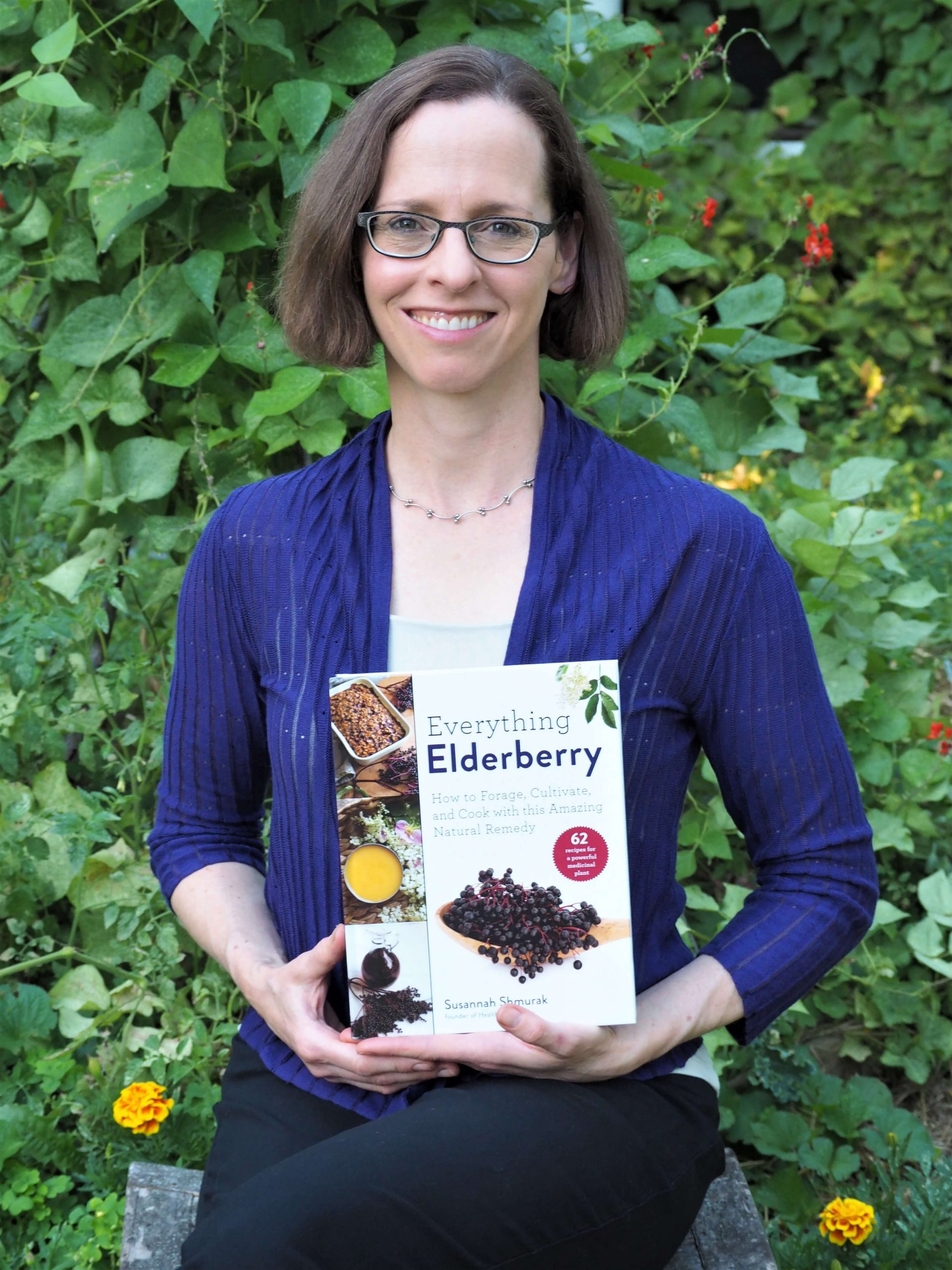Last Updated on April 2, 2025
Ever wondered what someone with professional training in permaculture design plants in their home garden? Read about this permaculture designer’s garden laboratory to find out!

If you’re curious about permaculture, permaculture designer Laura Freund’s inspiring home garden will give you a wealth of ideas to try out in your own yard.
From time to time I write magazine articles showcasing gardens in my region. I’m republishing them slowly here on HealthyGreenSavvy to help these gardeners’ great ideas reach a wider audience.
A version of this post appeared in the September/October 2022 issue of Northern Gardener Magazine.
Permaculture Design Takes Root
When Laura Freund bought her home in Brooklyn Center, Minnesota in 2008, she eyed the conventionally-landscaped yard and saw an opportunity. A permaculture designer with Minnesota-based Ecological Design, Freund immediately set to work converting the grass lawn into a garden brimming with fruit and wildlife.
Excited by the possibility of reenvisioning her traditional yard, Freund created a blank canvas to build upon by burying the turf grass in a foot-deep layer of wood chips she obtained from a local tree-trimming company. (Find out how to make your yard more eco-friendly with different kinds of grass alternatives.)
As she planted numerous trees and shrubs to replace the lawn, she came to view her landscape as an experimental laboratory for better understanding which perennial food plants would work in Minnesota’s challenging climate as well as in a residential-scale garden.
When she began, she found the options for plants and groupings she’d been taught in school rather limited and wanted to “expand her palette” of possible choices. Viewing her garden as “a place to play around with color, texture, flowers, insects, different conditions,” she set out to explore how she could “adapt permaculture ideas for an urban setting.”
Trained to design much larger landscapes, Freund found that some of the permaculture principles she’d been taught in school just didn’t work for smaller yards. For example, permaculture designs typically include vines that climb up fruit trees, but she learned that strategy doesn’t work with the dwarf trees one needs to use in smaller urban lots. “It just kills the tree,” she reports.
Further, she points out, plantings in the city “can’t be as wild” as might be acceptable in more rural areas. In urban and suburban settings, she’s found that “most people want to have a certain kind of order, and want neighbors to appreciate what they’ve done” with their landscape.
Once the layer of mulch was in place, Freund began adding fruit trees, then shrubs, and when the mulch had broken down a bit, perennials. With limited varieties available locally, she ordered plants from the West Coast to find out if they could survive Minnesota’s harsh winters. Over the ensuing years, she discovered that many could not and replaced her peach trees with paw paws and other plants more suited to her climate.
–> If you want to add more perennial food plants to your garden, be sure to check out these perennial vegetables and perennial herbs to consider.
What Grows in a Suburban Permaculture Garden?
More than fifteen years later, Freund’s yard boasts more than twenty-six types of fruiting trees, vines, and shrubs. As the season progresses honeyberries, juneberries, blueberries, cherries, currants, kiwis, grapes, apricots, pears, pawpaws, apples, and aronia ripen in different parts of the yard.
Her front yard includes a productive strawberry patch and many edible flowers. Native plants and perennial vegetables such as walking onions, rhubarb, and purple asparagus grow throughout the property.

Over the years, she’s learned a lot about what works and what doesn’t. In addition to the insight she’s gained about plants suited to small-scale and cold climate permaculture, tending her own garden has given her a better sense of how much time a landscape like hers requires, so she advises her clients accordingly.
“There’s an investment if you want a landscape like this,” she cautions.
Permaculture Design Isn’t Just About Plants
Another top priority in designing her garden: Creating spaces where her children would feel a “sense of belonging that you get from being part of a space and fed.” She observes that “culturally we are so far removed from growing and harvesting food and being in the world, we’re so indoors.” She wanted to ensure her kids had “a familiarity with plants and wildlife, and places to play and explore.”
To that end, she incorporated numerous areas for children, including a tree house and swings, a hammock, chairs, and a picnic table. Paths lead kids through the space to encourage their interaction with plants, insects, and other animals. Shady spots with seating invite visitors to sit, contemplate, and observe. Neighbors and friends who appreciate how her yard encourages nature exploration bring their children to enjoy it as well.

Having an inviting space with a constantly changing menu of foods to harvest means her family is “outside all the time” once the weather warms. Her two daughters, Ila, age 9, and Nyomi, age 5, have areas dedicated to plants they want to grow. They enjoy planting and nibbling edible flowers like nasturtiums and columbine.
During the summer, the family spends most of their waking hours outside, including meals served under the shade of their grape arbor. Nine-year-old Ila looks forward to the end of the school year so she can spend her days picking fruit and playing with her sister in the garden. “I spend all day out here if I can,” she says. “We make up fun games and play house in the tree fort,” a raised platform with a roof to shade them from the sun and protect them from rain, as well as a sofa with a grand view of the garden. Kids and adults alike enjoy relaxing and reading there.
Neighborhood children come often to play in the yard, examining insects and harvesting snacks from the hundreds of edible plants.

A Thriving Food Forest
More than fifteen years into her experiment, Freund’s food forest now has eighty-seven fruiting shrubs, vines, and trees as well as scores of edible perennials. One of the biggest challenges, she notes, is keeping up with the summer harvest.
From mid-June to mid-July, she reports that the garden “gets pretty out of control” while the family endeavors to harvest the superabundant strawberries, juneberries, and cherries. In fall, eating and preserving more than fifty pounds of pawpaws produced by her three thriving trees poses another challenge.

She’s given up the annual vegetable garden, which currently lies fallow as it’s “so much more labor-intensive” than the perennial food crops, and she can’t spare the time and energy for it. “It is so much more rewarding to have your blueberry bush or juneberry or currant give you a ton of food and you don’t really have to tend it at all. I prefer perennial vegetables way more,” she explains.
Along with the plentiful fruit ripening throughout the summer, she makes the most of her other perennial plants. She grows culinary herbs such as oregano, chervil, and chives, as well as medicinal herbs including valerian, meadowsweet, rosehips, and schizandra, and uses the leaves of her raspberry plants for tea.
She also harvests the many nutritious wild plants in the garden like stinging nettle, wild lettuce, dandelions, cucumber weed, purslane, and lambsquarters. In addition to being edible and delicious, she says, these wild plants help her other plants thrive by shading the soil and holding in moisture.
This Permaculture Garden Grows Community, Too
While nourishing her family, Freund’s garden also nurtures her own well-being. Acutely aware of how modern modes of living tend to keep people indoors and separate from one another, Freund has thought a great deal about how gardens can bring people together. She notes that in our culture people tend to shy away from using their front yards because they feel too visible, leading to families secluded in their backyards.
For her part, she remarks, “I don’t want to be isolated.” Because Freund and her family spend so much time harvesting in their front yard, opportunities to interact with neighbors are far more common.
–> If you’re interested in growing food in your front yard, check out these inspiring front yard vegetable gardens.
Her garden has fostered a community that comes together around the food they produce. Every year, she trades her abundance of strawberries and cherries with neighbors who have eggs and venison to share, which has helped create “more of a smaller community feel.” Her daughters help take care of neighbors’ chickens, and everyone trades recipes along with fresh, homegrown food.
Permaculture’s emphasis on gardens’ multiple functions reveals itself in her landscape as well. She has a compost, a clothesline, and a shrine to relatives that also serves as a spot to cure garlic in summer. She weaves low fences for pathways using dogwood, grapevines, and nettle stems and plans to use petals from her rose bushes to make fragrant beads.
A small flock of chickens keeps the family supplied with eggs while teaching her daughters about animal care and providing entertainment.

Mindful of the interdependence of people, plants, and wildlife, in recent years Freund has added more native plants with special attention to providing food for pollinators. “Most fruiting trees, shrubs and vines,” she notes, “flower in the early spring, and we need to provide for the pollinators throughout the season.”
An Evolving Landscape
The aesthetics of the garden are also at the forefront of her design decisions. “It’s really important to me that it be beautiful around me,” she explains. Freund considers her yard “very much a working landscape” rather something she has a plan to finish. “I don’t necessarily need it to be complete, that’s not my goal,” she says. She enjoys watching it constantly shifting and evolving and revels in sharing what she learns as she experiments.
When a street improvement project tore out much of the front yard, Freund jumped at the chance to display some of the alternatives to turf grass that can grow by the roadside. She put in native plants like echinacea, yarrow, golden Alexander, prairie phlox, asters, partridge pea, and other perennials that would help manage runoff and support pollinators. She left the plant markers where passersby could easily see them so they could learn which plants might thrive in such a location.

She aims to have her garden demonstrate that a residential yard can be aesthetically pleasing and environmentally positive while benefitting the people and animals that call it home. “I’m going towards a place where it looks like people are stewarding or interacting with this landscape, a mutually beneficial space” for all the creatures – humans, animals, insects – that use it.
Curious to try permaculture design in your own garden? Check out this quickstart guide to getting started.
Save this inspiring permaculture design for later!


Susannah is a proud garden geek and energy nerd who loves healthy food and natural remedies. Her work has appeared in Mother Earth Living, Ensia, Northern Gardener, Sierra, and on numerous websites. Her first book, Everything Elderberry, released in September 2020 and has been a #1 new release in holistic medicine, naturopathy, herb gardening, and other categories. Find out more and grab your copy here.

 Hi, I'm Susannah, a garden geek, energy nerd, and fan of healthy food and natural remedies. Need some simple, practical solutions for living healthier and greener? You've come to the right place! More about me and my green projects
Hi, I'm Susannah, a garden geek, energy nerd, and fan of healthy food and natural remedies. Need some simple, practical solutions for living healthier and greener? You've come to the right place! More about me and my green projects
Leave a Reply